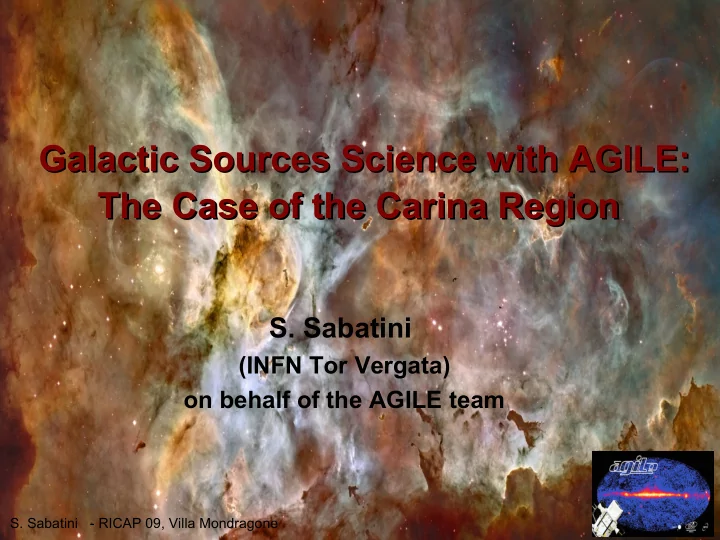

Galactic Sources Science with AGILE: Galactic Sources Science with AGILE: The Case of the Carina Region The Case of the Carina Region S. Sabatini (INFN Tor Vergata) on behalf of the AGILE team S. Sabatini - RICAP 09, Villa Mondragone
Main Galactic Science Topics • Diffuse gamma-ray emission • Pulsars • SNRs and origin of cosmic rays • Massive sources • Variable Galactic sources • Microquasars, Gal. compact objects • The Galactic center AGILE Galactic WG members: Barbiellini G., Bulgarelli A., Chen A., Caraveo P., Del Monte E., Evangelista Y., Giuliani A., Longo F., Pellizzoni A., Piano G., Pilia M., Pittori C., Rappoldi A.,Tavani M., Verrecchia F. S. Sabatini - RICAP 09, Villa Mondragone
• AGILE Observations vs Model (90 < l < 90) • Source POSITIONING For source counts of 100-1000 the positioning accuracy is ~ 5.5 arcmin S. Sabatini - RICAP 09, Villa Mondragone
The AGILE gamma-ray 2yr exposure (E > 100 MeV) S. Sabatini - RICAP 09, Villa Mondragone
The AGILE gamma-ray 1yr sky (E > 100 MeV) S. Sabatini - RICAP 09, Villa Mondragone
The AGILE gamma-ray 1yr sky (E > 100 MeV) CARINA REGION CRUX REGION CYGNUS REGION S. Sabatini - RICAP 09, Villa Mondragone
The CARINA REGION (MW observations) IRAS far-IR multicolor image Hubble Space Telescope (from N. Smith 2009 Handb. Star Form. Regions II p.138) UV rays & winds of numberless young hot stars produce a wealth of spectacular nebular structures X-Ray images AGILE gamma-ray map on same scale CHANDRA XMM-Newton ASCA Hamaguchi et al. 2007 ApJ 663, 522 S. Sabatini - RICAP 09, Villa Mondragone
The AGILE map of the Carina Region Combination of 8 pointings from July 2007 to October 2008 total exposure ~130 days (10600 ksec) 1AGL J1045-5832 > 100 MeV Westerlund 2 > 400 MeV 1AGL 1043-5931 (Eta Carinae) S. Sabatini - RICAP 09, Villa Mondragone
The ETA CARINAE system Eta Carinae as an interactive binary system: SYSTEM PARAMETERS Period: 5.54 years eccentricity: ~0.9 Last periastron: 11 January 2009 Primary: log L/L = 6.7 Secondary (unseen) = O supergiant Eta Car mass ~ 100 M mass outflow ~2 x 10 -4 M /yr wind speed ~ 600 km/s Companion ~ 30 M mass outflow ~2 x 10 -5 M /yr wind speed ~ 3000 km/s S. Sabatini - RICAP 09, Villa Mondragone
X-ray MONITORING • 2-10 keV rays from eta Carinae The RossiXTE light curve during 1996-2009 Overlap of the 3 X-ray minima 1998.0 2003.5 2009.0 Courtesy of M. F. Corcoran • INTEGRAL 20-50 keV image 3 sources found by INTEGRAL in PDS FoV, Eta Car is the strongest. No emission from the CW binary WR25. Leyder et al. 2008 A&A 477, L29 S. Sabatini - RICAP 09, Villa Mondragone
Possible Model for the X-ray emission Two components: soft from circumstellar matter (constant) and hard from wind-wind collision region (increasing when approaching periastron, then eclipsed by opaque matter) Hamaguchi et al 2007 ApJ 663, 522 S. Sabatini - RICAP 09, Villa Mondragone
Gamma-ray emission from Eta Carinae The source was positively detected during several individual observing runs showing a roughly constant gamma-ray flux over the whole observations period. The October 2008 maximum is due to a flare (see next slide) rather than to a flux increase before periastron as in X-rays. Analysis of the deep AGILE integration around eta Carinae: 7.8 σ detection (l,b) = 287.6, -0.7 ± 0.3 (stat) ± 0.1 (syst) F γ = (37 ± 5) x 10 -8 ph/cm 2 /s L γ = 3.4 x 1034 erg/s (2.3 Kpc dist) Tavani et al. 2009 ApJL in press ( arXiv:0904.2736 ) S. Sabatini - RICAP 09, Villa Mondragone
The 11-13th Oct 2008 Eta Car Flare 11-13 Ott 08 5.2 σ detection (l,b) = 288.0, -0.4 ± 0.6 F γ = (270 ± 65) x 10 -8 ph/cm 2 /s L γ = 2 x 10 35 erg/s 2 days integration maps - counterclockwise S. Sabatini - RICAP 09, Villa Mondragone
100 MeV vs 400 MeV maps > 100 MeV > 400 MeV The gamma-ray flare of Oct 11-13th 2008 is mainly due to photons of energy lower than 400MeV S. Sabatini - RICAP 09, Villa Mondragone
The keV to MeV Energy Spectrum of eta Carinae Oct 2008 Flare SAX MECS Average emission AGILE INTEGRAL Although data are not simultaneous, it is interesting to note that the average AGILE spectrum together with the INTEGRAL historical spectrum is in qualitative agreement with expectations based on inverse Compton and/or pion decay models of gamma-ray emission from colliding wind binaries (Raimer et al, 2006) S. Sabatini - RICAP 09, Villa Mondragone
Conclusions AGILE detected a point source centered on the object Eta Carinae Identification with the Eta Carinae is supported by: • Eta Car is a very massive and powerful CW binary system • It has a non-thermal X-ray excess (BSAX, INTEGRAL, SUZAKU) • It is the strongest and hardest 2-10 and 22-100 KeV source in the field • The two nearby hard X-ray sources detected by INTEGRAL are outside the AGILE error box • Time variability both in X- and gamma-rays • Multiple gamma-ray sources within the AGILE detection error box are unlikely • No alternative identification so far This would be the first remarkable detection above 100 MeV of a colliding wind binary system, confirming the efficiency of particle acceleration and the highly non-thermal nature of the strong shock in a CWB. S. Sabatini - RICAP 09, Villa Mondragone
Recommend
More recommend